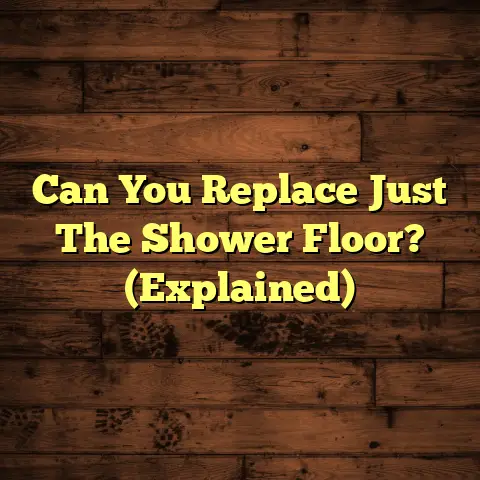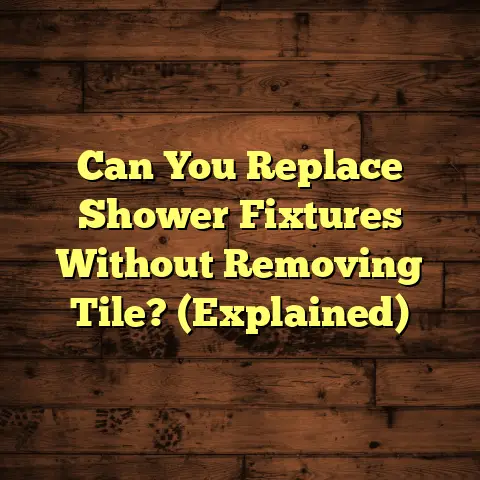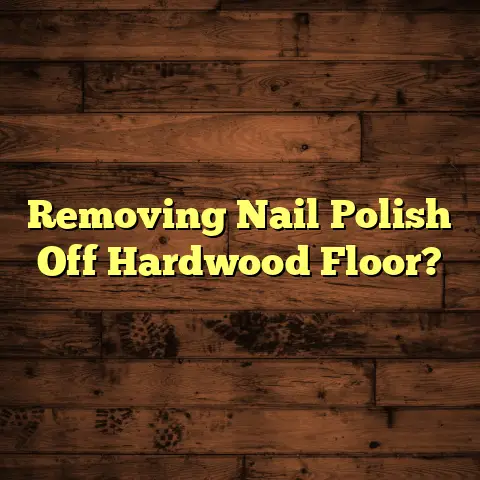Remove Wax Buildup? (2 Floor Finish Killers!)
A clean, shiny floor can really transform a space, right?
Whether it’s the warm glow of hardwood, the sleek look of vinyl, the cool elegance of tile, or the practicality of laminate, every floor type has the potential to be a showstopper.
But let’s be real, keeping them clean can sometimes feel like a never-ending battle.
And that’s where wax buildup comes in – a sneaky culprit that can turn your beautiful floors into a dull, slippery mess.
As a flooring contractor with years of experience, I’ve seen it all.
And trust me, wax buildup is a problem I tackle more often than you might think.
So, let’s dive into what wax buildup is, why it happens, and, most importantly, how to kick it to the curb!
Understanding Wax Buildup
Okay, so what exactly is wax buildup?
Simply put, it’s the accumulation of layers of wax or cleaning product residue on your floor over time.
Think of it like this: you apply wax to protect and shine your floors, which is great, but over time, each layer doesn’t fully wear away.
Instead, it builds upon the previous layer, trapping dirt, dust, and grime in the process.
This creates a cloudy, dull surface that’s far from the shiny, clean floor we all want.
Where does this wax buildup come from?
Well, there are a few common sources:
- Improper Cleaning Techniques: Using too much cleaning product, not rinsing thoroughly, or using the wrong type of mop can all contribute to buildup.
- Incorrect Cleaning Products: Some cleaners contain ingredients that leave behind a residue, which then attracts more dirt and grime.
- Over-Waxing: Applying too many coats of wax, or waxing too frequently, can quickly lead to a thick, unsightly buildup.
The aesthetic and functional drawbacks of wax buildup are pretty significant.
Aesthetically, it makes your floors look dull, dirty, and uneven.
Functionally, it can make your floors slippery, which is a safety hazard, especially for kids and the elderly.
Plus, it makes cleaning even more difficult because the buildup traps dirt and prevents your cleaning products from working effectively.
You might be surprised to know just how common wax buildup is.
According to a recent survey by the National Floor Covering Association (NFCA), approximately 60% of homeowners and 70% of businesses report dealing with wax buildup issues at some point.
That’s a lot of people struggling with the same problem!
And it’s not just a cosmetic issue.
The NFCA also estimates that wax buildup contributes to over $500 million in floor maintenance and repair costs annually.
These numbers show that wax buildup isn’t something to ignore.
It affects a large number of people and costs them money, and it is important to address it properly.
Identifying the Two Floor Finish Killers
Alright, let’s get to the heart of the matter: the two main culprits that exacerbate wax buildup.
I call them the “floor finish killers” because they can slowly but surely ruin your beautiful floors.
These are the guys you need to watch out for!
Killer 1: Incorrect Cleaning Products
This is a big one.
I can’t tell you how many times I’ve seen floors damaged by the wrong cleaning products.
It’s like feeding your car the wrong type of fuel – it might run for a while, but eventually, it’s going to cause problems.
So, how do certain cleaning products contribute to wax buildup?
Well, it all comes down to the ingredients.
Many common cleaners contain ingredients like:
- Oils: These can leave a residue that attracts dirt and grime.
- Soaps: Some soaps create a film on the floor, which builds up over time.
- Polymers: These are often added to give floors a temporary shine, but they can also create a sticky layer that traps dirt.
These residues layer on top of each other with each cleaning, creating a buildup that’s tough to remove.
Let me give you some specific examples.
For hardwood floors, avoid using oil-based soaps or wax-based cleaners.
These can penetrate the wood and leave a sticky residue that’s difficult to remove.
For vinyl floors, steer clear of abrasive cleaners or solvents.
These can damage the finish and leave a dull, cloudy appearance.
For tile floors, avoid using acidic cleaners, especially on natural stone tiles.
These can etch the surface and leave a dull, uneven finish.
I remember one time I was called to a house where the homeowner had been using a popular “mop and shine” type cleaner on their hardwood floors for years.
The floors looked terrible – they were dull, sticky, and covered in a thick layer of buildup.
It took me hours to strip the floors and refinish them, and the homeowner ended up spending a lot of money.
The lesson?
Always read the labels
on your cleaning products and
make sure they’re specifically
designed for your floor type.
And when in doubt, test the cleaner on a small, inconspicuous area first to see how it reacts.
Trust me, a little bit of prevention can save you a lot of headaches (and money) down the road.
Killer 2: Over-Waxing
Okay, now let’s talk about over-waxing.
This is another common mistake that I see all the time.
People think that if a little wax is good, a lot of wax must be even better, right?
Wrong!
Over-waxing is like putting too much fertilizer on your plants – it can actually do more harm than good.
So, what exactly is over-waxing?
It’s simply applying too many coats of wax to your floors, or waxing too frequently.
The process of waxing involves applying a thin, even layer of wax to your floors to protect them and give them a shine.
How often should you wax your floors?
Well, it depends on a few factors, including the type of floor, the amount of traffic it gets, and the type of wax you’re using.
As a general rule, I recommend waxing hardwood floors every 3-6 months, and vinyl floors every 6-12 months.
But those are just guidelines.
The best way to determine if your floors need waxing is to look for these signs:
- Dullness: If your floors have lost their shine and look dull, it might be time to wax.
- Scratches: If your floors are easily scratched or scuffed, waxing can help protect them.
- Water Spots: If water spots don’t wipe away easily, it might be time to wax.
Now, here’s where things get tricky.
When you apply too many coats of wax, or wax too frequently, the wax can build up on the surface of the floor.
This buildup can trap dirt and grime, making your floors look dull and dirty.
It can also make your floors slippery, which is a safety hazard.
And, as we discussed earlier, it can make cleaning even more difficult.
The implications of applying too many coats of wax can be pretty serious.
I’ve seen floors that have been so heavily waxed that they look like they’re covered in a thick, yellow film.
It’s not a pretty sight!
And removing that buildup can be a real pain.
It often requires stripping the floors with harsh chemicals, which can damage the underlying finish.
I once worked with a flooring specialist who told me a story about a homeowner who had been waxing their hardwood floors every month for years.
The floors were so heavily waxed that they looked like they were covered in a layer of plastic.
The homeowner had no idea that they were actually damaging their floors by over-waxing them.
The specialist had to spend days stripping the floors and refinishing them, and it cost the homeowner thousands of dollars.
The moral of the story?
Don’t over-wax your floors!
Follow the manufacturer’s instructions for the type of wax you’re using, and only wax your floors when they actually need it.
And if you’re not sure, it’s always best to err on the side of caution.
The Consequences of Wax Buildup
Okay, so we’ve talked about what wax buildup is and the two main culprits that cause it.
Now, let’s talk about the consequences.
What happens when wax buildup is allowed to accumulate on your floors?
Well, the effects can be pretty negative.
Let’s start with the aesthetic issues.
As we’ve already discussed, wax buildup can make your floors look dull, dirty, and uneven.
It can also cause discoloration, especially in areas that get a lot of traffic.
For example, you might notice that the areas around your doorways or in front of your kitchen sink are darker and dirtier than the rest of the floor.
This is because those areas are more likely to accumulate wax buildup.
But the problems don’t stop there.
Wax buildup can also lead to some pretty serious practical issues.
One of the biggest is increased slipperiness.
As wax builds up on the surface of the floor, it can create a slick, uneven surface that’s easy to slip on.
This is especially dangerous for kids, the elderly, and people with mobility issues.
Another practical issue is difficulty in cleaning.
As wax buildup accumulates, it traps dirt and grime, making it harder to clean your floors.
You might find that your mop or cleaning solution just glides over the surface of the floor, without actually removing any dirt.
And that’s not all.
Wax buildup can also damage the floor surface itself.
Over time, the buildup can cause the finish on your floors to crack, peel, or fade.
This can lead to more serious problems, such as water damage or rot.
And, in some cases, wax buildup can even attract pests, such as ants or cockroaches.
All of these issues can lead to more significant maintenance problems.
If wax buildup is allowed to accumulate for too long, it can become so difficult to remove that you’ll need to hire a professional cleaning service.
And, in some cases, the damage to your floors might be so severe that you’ll need to refinish or even replace them.
Refinishing or replacing your floors can be a costly and time-consuming process.
According to HomeAdvisor, the average cost to refinish hardwood floors is between $3 and $8 per square foot.
And the average cost to replace hardwood floors is between $6 and $12 per square foot.
So, as you can see, wax buildup can have some pretty serious consequences.
It can affect the appearance of your floors, make them slippery and difficult to clean, and even damage the floor surface itself.
And, in the long run, it can lead to more significant maintenance problems and costly repairs.
That’s why it’s so important to take steps to prevent wax buildup in the first place.
And, if you already have wax buildup on your floors, it’s important to remove it as soon as possible.
Strategies for Removal
Alright, so you’ve got wax buildup on your floors.
Don’t panic!
There are strategies for removing it.
Here’s a step-by-step guide on how to effectively remove wax buildup from various flooring types.
General Tips (Applicable to All Floor Types):
- Test First: Always test any
cleaning method on a small,
inconspicuous area of your floor
before applying it to the entire
surface.
This will help you ensure that the cleaning method doesn’t damage or discolor your floors. - Ventilate: Open windows and doors to provide adequate ventilation, especially when using chemical cleaners.
- Protect Yourself: Wear gloves and eye protection to protect your skin and eyes from harsh chemicals.
Hardwood Floors:
- Gather Your Supplies: You’ll need a bucket, warm water, mild dish soap (or a hardwood floor cleaner), a soft-bristled brush, and a clean mop.
- Prepare the Solution: Mix a small amount of dish soap (or hardwood floor cleaner) with warm water in the bucket.
- Apply the Solution: Dip the
soft-bristled brush into the
solution and gently scrub the
affected areas of the floor.
Avoid using too much water, as this can damage the wood. - Rinse the Floor: Use a clean, damp mop to rinse the floor and remove any remaining soap residue.
- Dry the Floor: Use a clean, dry towel to dry the floor thoroughly.
Vinyl Floors:
- Gather Your Supplies: You’ll need a bucket, warm water, vinegar, a soft-bristled brush, and a clean mop.
- Prepare the Solution: Mix equal parts warm water and vinegar in the bucket.
- Apply the Solution: Dip the soft-bristled brush into the solution and gently scrub the affected areas of the floor.
- Rinse the Floor: Use a clean, damp mop to rinse the floor and remove any remaining vinegar residue.
- Dry the Floor: Use a clean, dry towel to dry the floor thoroughly.
Tile Floors:
- Gather Your Supplies: You’ll need a bucket, warm water, baking soda, a stiff-bristled brush, and a clean mop.
- Prepare the Solution: Mix baking soda with warm water to form a paste.
- Apply the Solution: Apply the paste to the affected areas of the floor and let it sit for 10-15 minutes.
- Scrub the Floor: Use the stiff-bristled brush to scrub the floor and remove the wax buildup.
- Rinse the Floor: Use a clean, damp mop to rinse the floor and remove any remaining baking soda residue.
- Dry the Floor: Use a clean, dry towel to dry the floor thoroughly.
Laminate Floors:
- Gather Your Supplies: You’ll need a bucket, warm water, mild dish soap (or a laminate floor cleaner), a soft-bristled brush, and a clean mop.
- Prepare the Solution: Mix a small amount of dish soap (or laminate floor cleaner) with warm water in the bucket.
- Apply the Solution: Dip the
soft-bristled brush into the
solution and gently scrub the
affected areas of the floor.
Avoid using too much water, as this can damage the laminate. - Rinse the Floor: Use a clean, damp mop to rinse the floor and remove any remaining soap residue.
- Dry the Floor: Use a clean, dry towel to dry the floor thoroughly.
Safety Precautions:
- Read Labels: Always read and follow the manufacturer’s instructions for any cleaning products you use.
- Ventilation: Ensure adequate ventilation when using chemical cleaners.
- Protective Gear: Wear gloves and eye protection to protect your skin and eyes.
- Avoid Mixing Chemicals: Never mix different cleaning chemicals, as this can create dangerous fumes.
If you’ve tried these methods and you’re still struggling to remove wax buildup from your floors, it might be time to call in a professional.
A professional cleaning service will have the tools and expertise to safely and effectively remove wax buildup without damaging your floors.
Conclusion
So, there you have it – a comprehensive guide to understanding wax buildup and the two major floor finish killers.
We’ve covered what wax buildup is, how it forms, the consequences of allowing it to accumulate, and strategies for removing it.
I hope this article has been helpful and informative.
Remember, proper cleaning and maintenance practices are key to preventing wax buildup in the future.
Avoid using incorrect cleaning products, don’t over-wax your floors, and always follow the manufacturer’s instructions for any cleaning products you use.
By taking these simple steps, you can keep your floors looking beautiful for years to come.
And, if you’re already dealing with wax buildup, don’t despair!
With a little bit of elbow grease and the right cleaning methods, you can remove the buildup and restore your floors to their former glory.
So, what are you waiting for?
Get out there and take action!
Your floors will thank you for it.





